Celebrating 25 years of research training to combat HIV/AIDS
July / August 2012 | Volume 11, Issue 4
Turn back the clock 25 years and research laboratory equipment in some developing countries amounted to no more than a mirror and a light microscope sitting on a desk. As a result, it was not uncommon for so-called "parachute scientists" from the U.S. or Europe to drop in for a quick visit to collect data and samples and take them home for analysis. Today, the scene looks much different, with well-trained local researchers using cutting-edge equipment and working as equal partners in collaboration with their counterparts around the world.
Driving this dramatic change has been a devastating catalyst: the HIV/AIDS epidemic. To date, more than 30 million people have succumbed and more than 34 million are infected, according to the WHO. Sub-Saharan Africa has borne the heaviest burden, virtually losing a generation and now harboring two-thirds of all people in the world living with the disease.
From the start, scientists recognized that research into this mysterious new disease was badly needed, not only in the developed world, but also in countries with different experiences in transmission, testing and patient care. But there was an enormous barrier: the lack of research capacity in areas most severely hit by the epidemic.
An idea for a novel program takes shape
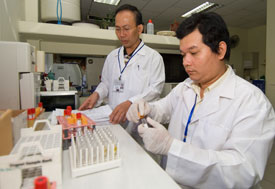
Photo by David Snyder for Fogarty/NIH
More than 2,000 physicians and scientists in 100
developing countries have received training through
Fogarty's novel AIDS International Training and
Research Program (AITRP).
Moved by the scale of the epidemic, Fogarty's Dr. Ken Bridbord took action. He sketched out a novel research training program that would arm promising developing country scientists with skills in epidemiology, lab techniques, ethical research practices and data analysis - in addition to subject matter expertise in HIV/AIDS and related diseases. The trainees would remain engaged in research studies of importance to their own communities and receive support to continue their projects when they returned home, a feature designed to prevent brain drain and ensure their expertise was deployed where it was needed most.
The
AIDS International Training and Research Program, known as AITRP, began in 1988 and has since provided significant research training to more than 2,000 individuals from more than 100 countries. (See related article,
Q and A with Dr. Ken Bridbord.) It is now managed by program officer Dr. Jeanne McDermott.
One U.S. investigator recalls the void in which AITRP germinated. "We got a lot of samples from different places in Africa and Asia and brought them to Boston for testing, because there was no way to test them there - they didn't have the equipment or personnel, didn't have the tests," said Dr. Max Essex of the Harvard School of Public Health. Essex received one of the first AITRP grants, as did other investigators cited in this article.
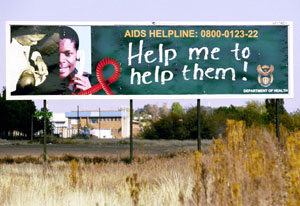
Photo by Trevor Samson/World Bank
Reacting to the alarming spread of AIDS around the world,
Fogarty created a unique grants program to build
sustainable research capacity around the globe.
Fogarty's approach was groundbreaking and helped to build the level of expertise necessary for sustained research efforts to study the HIV/AIDS epidemic on the ground in the locations where suffering was greatest. AITRP alumni returned home not only to conduct research projects critical to their home countries but also to train others, adding to the impact.
"It was clear we needed to enter into a partnership with colleagues in countries hardest hit," said Bridbord, now director of the Division of International Training and Research at Fogarty. "Perhaps no single word captures the essence of AITRP more than empowerment. AITRP trainees are empowered with the knowledge, experience and increased confidence to return home and become scientific and public health leaders in the struggle against HIV/AIDS."
Fogarty's new approach was not universally embraced. "There was a lot of skepticism about the logic of this kind of support, would it work in a country like, say, Haiti," said Dr. Warren Johnson, a longtime AITRP grantee at Weill Cornell Medical College. "It was visionary."
Johnson's partner in Haiti, Dr. Jean "Bill" Pape, founder and director of GHESKIO, said AITRP has been essential to his country's response to the HIV epidemic. "At our site, we rest on three legs: research, training and services. They are all interrelated and one makes the other one stronger. So it is through research that we find results, it is through training that we expand the results, and the services get the benefit of both the research and the training. And Fogarty has been instrumental in all three aspects."
A cadre of developing country scientists is trained
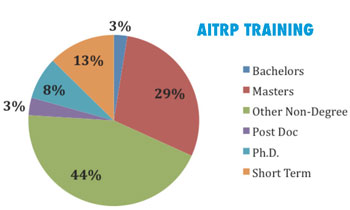
Source: Fogarty's CareerTrac system. Data are incomplete, but
give a snapshot of the more than 2,000 people trained under the
AIDS International Research and Training Program.
Under the program, developing country trainees were selected to come to the U.S. grantee institutions to learn from experts and work in well-equipped laboratories. Training courses were short- or long-term and covered many different levels and topics, including master's and doctoral degrees, laboratory skills, proposal and paper writing, epidemiology, biostatistics, ethics and HIV/AIDS related biology.
"The training provided people with a skill set that they didn't have before, how to approach and analyze a problem, design a study, choose the right study, conducting perhaps more quantitative epidemiologic types of research," said Dr. Art Reingold, who manages an AITRP grant at the University of California, Berkeley School of Public Health. "We also stressed the ethical aspects of research and encouraged a more questioning, intellectually stimulating approach in general."
Another unique aspect of AITRP was how it encouraged trainees to exercise their new skills back at home. After their education in the West, many scientists face the temptation to remain abroad in relatively well-paid jobs, leaving their home country no better off. So the AITRP grantees incorporated both a carrot and a stick. The carrot was re-entry funding for mentored research projects at home, where support might otherwise be hard to obtain. Many trainees have chosen to continue to extend their degree projects or launch new studies on HIV-related topics of particular interest in their country, such as how to treat HIV-positive children who are also malnourished.

Photo by Sebastian Szyd/World Bank
Fogarty's AITRP grants built a cadre of qualified
researchers who have helped make scientific
discoveries that have changed infection from a
death sentence to a chronic disease that can be
managed by drugs.
The stick was an explicit expectation that the trainees should return home and put their new knowledge and skills to work, as a way to repay their AITRP support. These conditions encouraged the flow of bright, qualified and empowered scientists back to developing countries, making the overall AITRP re-entry success rate in excess of 80 percent.
"We trained more than 65 graduate level trainees through AITRP over the years and 95 percent of them are back in Uganda today, working in various aspects of academics or in the Ministry of Health or working in the private sector on HIV-related issues," said Dr. Christopher C. Whalen, of Case Western Reserve University.
As skilled scientists became established in developing countries, they made attractive partners for global research collaborations and began to successfully compete for NIH research grants, in addition to funding from international foundations and other sources.
AITRP incorporates an unusual degree of flexibility, allowing the grantees to adapt to changing conditions. "As the epidemics evolve, the position of Fogarty has always been that if it was logical to change directions, follow new opportunities, fine, go ahead and do it," Johnson said.
Changing the research landscape in developing countries
Around the globe, the ability to conduct research in HIV/AIDS has expanded exponentially over the past two-and-a-half decades and AITRP is hailed widely for its role. AITRP has also provided the model for other Fogarty training programs.
UC Berkeley, for one, has had AITRP funding continuously since 1988. "We've seen a whole series of individuals go through the program who are back in their home countries now and doing pretty phenomenal work; whether it's in Uganda, Zimbabwe, or some other institutions or countries, it's the collective effort that is really impressive in terms of what has come out of all of this," Reingold said.
One shining example of AITRP's impact is in Malawi. "When we started the program, Malawi did not have a medical school. It had a very limited professional base. Malawians who had medical training were trained either in the UK or other African countries. There was really very little in the way of advanced technical capacity to respond to the epidemic and to do research," said Dr. Christopher Beyrer, of Johns Hopkins Bloomberg School of Public Health.
Into this vacuum came investments from AITRP and others, which have continued for the past couple of decades. Beyrer recently visited Malawi to discuss interests and objectives for the next round of funding with grantees and at their urging visited policymakers. "I met with the Minister of Health, the head of the National AIDS program and the head of the immunization program - and all of them had had training through our AITRP. You realize that you have really helped build in-country expertise. That was very powerful for me," he said.
Longtime AITRP collaborator in Uganda, Dr. David Serwadda, of Makerere University, said the program concept is unique. "Fogarty's model of integrating training and research has been more successful than the model in which scholarships are given, Ugandans go to train, and they come back and say ‘Now, what? - What am I going to do?' Those programs tend to have a much higher brain drain compared to Fogarty's."
AITRP trainees contribute to scientific discoveries

Photo by Richard Lord for Fogarty/NIH
Studies in developing countries brought
valuable findings on how to significantly
reduce the transmission of HIV between
an infectious mother and her baby, including
through breastfeeding.
Former AITRP trainees around the world have made enormous contributions to virtually every area of HIV/AIDS science. (See the related article
Scientific findings by NIH-funded studies featuring former AITRP trainees.) "The trainees contribute to critical research projects," said Myron (Mike) Cohen, of the University of North Carolina. "This is not a hobby. This is deadly serious science."
Grantees are happy to give name after name of trainees who are living proof that AITRP was a success in the multiple ways they are extending their country's ability to research, manage and improve global health. (See the profiles of AITRP trainees
Shifting Pakistan's health approach,
Combating AIDS in Malawi, and
Preventing HIV in Uganda.)
Because some developing countries have much larger numbers of HIV-positive patients, they are better positioned to carry out high-quality clinical trials in, for example, pediatric AIDS and mother-to-child transmission. "There were many aspects of AIDS you couldn't learn about as efficiently, if at all, by looking at just western populations," said Dr. Roger Detels, AITRP grantee at the University of California Los Angeles School of Public Health.
Columbia University's AITRP has supported an important collaboration with the Centre for the AIDS Programme of Research in South Africa (CAPRISA), led by Drs. Salim Abdool Karim and Quarraisha Abdool Karim, for much of the project's 20-year history. CAPRISA has produced groundbreaking studies on microbicides, among other issues.
Many studies conducted in developing countries had broader implications. "Just like overseas, it's sometimes hard to get people tested in the U.S., prevention is often elusive and it's hard to access certain subpopulations at highest risk, whether they're sex workers or gay men in the U.S. or Zambia," said Dr. Sten H. Vermund, of Vanderbilt University, formerly of the University of Alabama at Birmingham. "So there is a lot more resonance in these research themes than people might realize."
Multiplying AITRP's impact
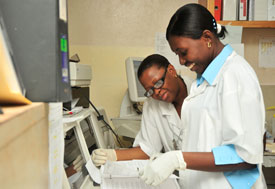
Photo by Hugue-Robert Marsan for Fogarty/NIH
Low-income countries have critical shortages of
expertise in informatics and data analysis, which
Fogarty's research training programs address.
Fostering long-term research collaborations is a key factor in AITRP's success. By providing a forum for sharing information and lessons learned, the program's impact is multiplied. One grantee cited how the head of China's AIDS program, after observing HIV was spreading in sex workers, reached out to AITRP alumni in Thailand who had already implemented an effective condom promotion program to reduce transmission. "When you go through graduate training together, it's like being in the trenches, you sort of become buddies," Detels said. "That kind of interaction and mutual support between people from different countries really wasn't going on in the ‘80s, but is now."
AITRP alumni Dr. Peter Cherutich was greatly influenced by exposure to the U.S. academic research environment, recalls University of Washington AITRP grantee Dr. Carey Farquhar. "When he came over, he saw role models doing what he wanted to do, and that was life-changing for him." Cherutich subsequently helped lead his country's successful circumcision program and now directs the sexually-transmitted disease control program at Kenya's Ministry of Health.
Success begets success. When well-qualified people remain at home, rise through the ranks and keep connected, they become the go-to people for HIV/AIDS in their country and attract funding from international agencies. "Leveraging is widespread and inevitable. I don't know anybody with an AITRP where it wasn't leveraged into something way bigger than the AITRP," Cohen said.
As former AITRP trainees have added to their country's pool of expert scientists and health leaders, they have helped lay the groundwork for other U.S. efforts, such as the President's Emergency Plan for AIDS Relief (PEPFAR). These projects then feed research further, allowing experts on the ground to craft new research projects involving PEPFAR patients, AITRP grantees noted.
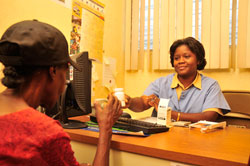
Photo by Hugue-Robert Marsan
for Fogarty/NIH
Studies conducted by Fogarty trainees in Haiti
proved adherence is possible in low-income
settings.
In Zambia, AITRP helped spark tremendous research expansion. "Our initial success in grants in Zambia were two small Elizabeth Glaser Pediatric AIDS Foundation grants, along with our AITRP," Vermund said. "In 2001, we had a program funded in the $300,000 range. By 2011, it was $34 million a year. So there's no question that the people that were trained under AITRP and some of the projects that they did for their master's and doctoral projects were highly relevant in building our credibility to be able to apply for the larger programs."
At Uganda's Makerere University, many of the school of public health staff were trained through AITRP, Whalen recalled. "And that school is on par with any school of public health here in the U.S. The pressures are a little different on the faculty, but the knowledge and expertise and publication record of the faculty is just extraordinary and most of that as a result of AITRP."
Although AITRP intends for trainees to return home and build in-country capacity, sometimes careers draw individuals in other directions. This can work out for the best, though, remembered Vermund. "Dr. Isaac Zulu was a terrible loss when he left the University of Zambia, because he was one of their most talented researchers, trained in our AITRP. But he went to the CDC/Zambia and spearheaded a capacity building initiative through PEPFAR that brought substantial resources to the university. So sometimes you think you've lost something but you end up gaining."
AITRP changes the academic culture
Visiting the U.S. for training has been a valuable experience on many levels for AITRP trainees, some of whom have not traveled outside their country before. The U.S. academic teaching styles often differ substantially from what they are used to, for instance in the interaction with mentors, style of networking and examples of role models.
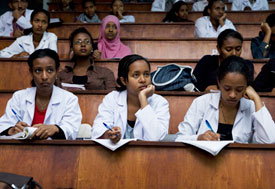
Photo by Richard Lord for Fogarty/NIH
AITRP trainees exposed to the U.S. academic culture
not only learned about science topics but also
became familiar with a more questioning, interactive
approach to education and research.
Many trainees come from former British or French colonies, where the education system remains based on top-down, didactic teaching. "Education there basically amounts to professors talking to you, you writing it all down, being tested on how well you wrote it down and remembered it. It's not an interactive process where you argue, disagree, discuss, and that is central to the way we educate people in our graduate school," Reingold observed. "I think many of them do go home with a refreshingly more candid, open, argumentative (in a good way) approach to things, questioning their elders or the system or how things are done and that's a good thing."
Many developing countries did not have a tradition of research as part of academia and AITRP provided roadmap for success. "It really helped lay down the template showing that a large part of achieving academic success is through international-level research, collaboration, publication, and presentations," Beyrer said.
Bringing benefits for US institutions
AITRP has increased capacity at U.S. institutions as well, as the recipient universities have established or expanded their global health departments and attracted larger numbers of U.S. as well as visiting students. The visiting trainees bring an added dimension to classroom discussions with their first-hand knowledge of conditions and needs. The connections formed often lead to long-term research collaborations and lasting friendships.
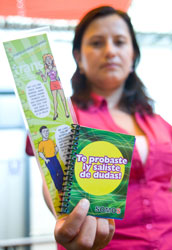
Photo by David Snyder
for Fogarty/NIH
AITRP trainees have conducted
studies on HIV prevention
strategies suited for low-
resource settings.
"We have some Americans who were minimally involved in international health, an AITRP trainee came into their lives and the next thing you know they were deeply involved," Vermund said. "Having those talented international students enhances the richness of the student pool here."
Faculty members and both U.S. and visiting trainees gain from their experience of working together. "We develop these relationships which shape our lives. We don't look at the world the same way, because we're working with people from other countries," Cohen said. "I can see generations of people from other countries, as well as from our faculty, whose not just careers but personal lives, personalities, view of the world are all really shaped by AITRP."
Preparing to meet new challenges
Twenty-five years after AITRP's birth, HIV/AIDS is still a scourge that needs extensive study. However, research is shifting from its earlier focus of identifying HIV infection, clinical manifestations and transmission modes toward treating HIV as a chronic disease, dealing with co-infections and studying the effects of treatment over time. For instance, scientists do not understand why long-term antiretroviral treatment, while extending life, also accelerates aging and the development of related conditions such as cardiovascular disease and certain cancers.
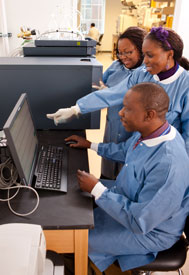
Photo by Douglas Levere/
University at Buffalo
AITRP trainees learn new skills in
areas ranging from epidemiology
to microbiology to bioethics, which
they then pass on to others, thereby
expanding their country's pool of
qualified researchers.
To meet these new challenges, Fogarty has consolidated AITRP with another implementation research training effort, into the new
Fogarty HIV Research Training Program. While the areas for training permitted under the new program will be broad - to include various aspects of HIV-related research - each project will focus on building or strengthening capacity in a particular scientific or critical research infrastructure area of importance to a developing country institution. The new initiative will measure outcome indicators focused on increased research capacity for more meaningful monitoring and evaluation.
As AITRP transitions to this new program after a quarter century, those who participated take stock of its accomplishments. "I remember when AITRP was just an idea in '85. To see it evolve in the magnificent way it has is really hard to believe. The breadth of the effect of AITRP has been remarkable," said Dr. Charles Carpenter of Brown University.
Summing up the widely held position among AITRP grantees, Beyer concluded: "There's no question that the training and the empowerment of the developing country scientists and their institutions to do AIDS research has just been enormous. Without it, we would not be anywhere near where we are today in the global response. It is a powerful legacy."
More Information
To view Adobe PDF files,
download current, free accessible plug-ins from Adobe's website.